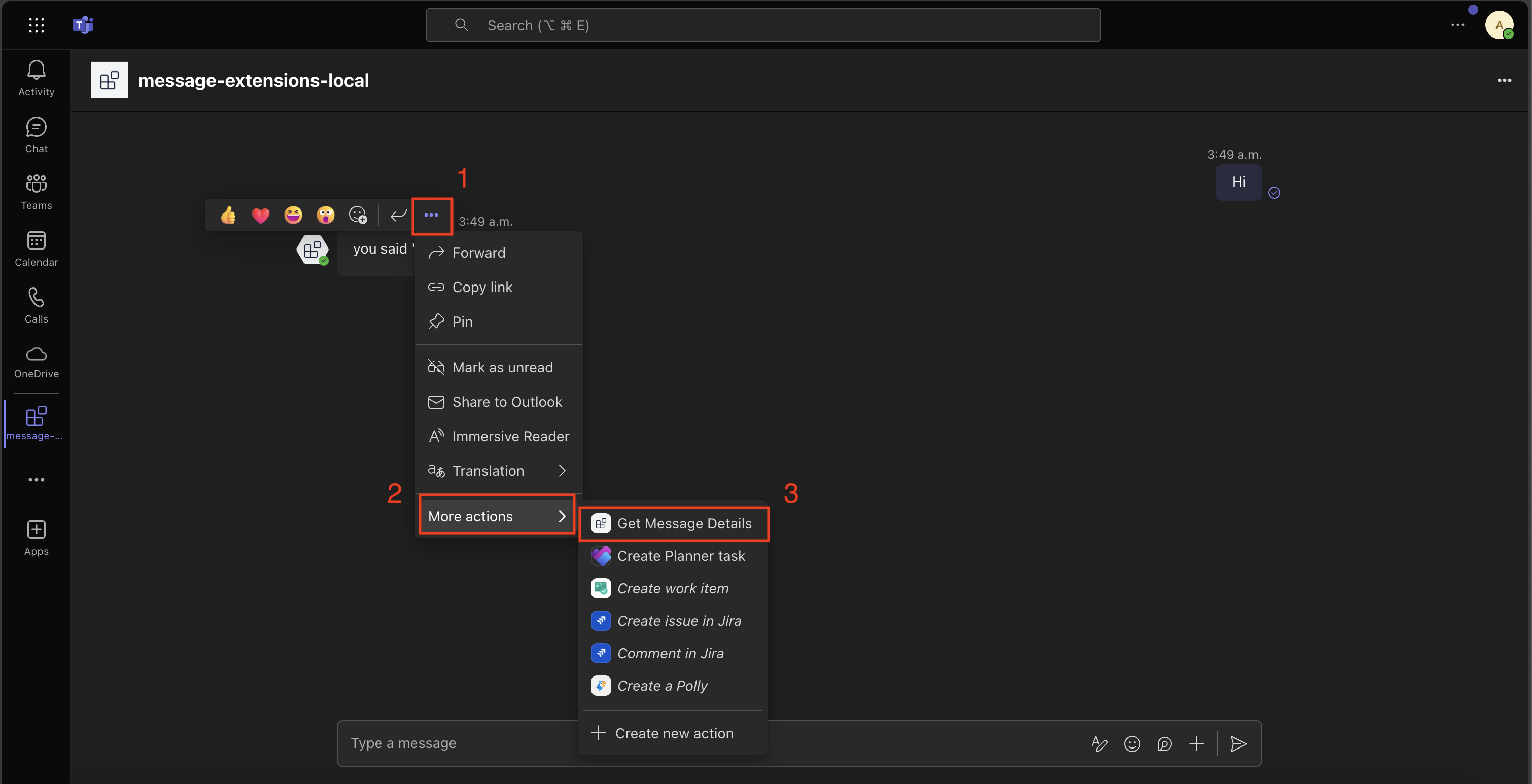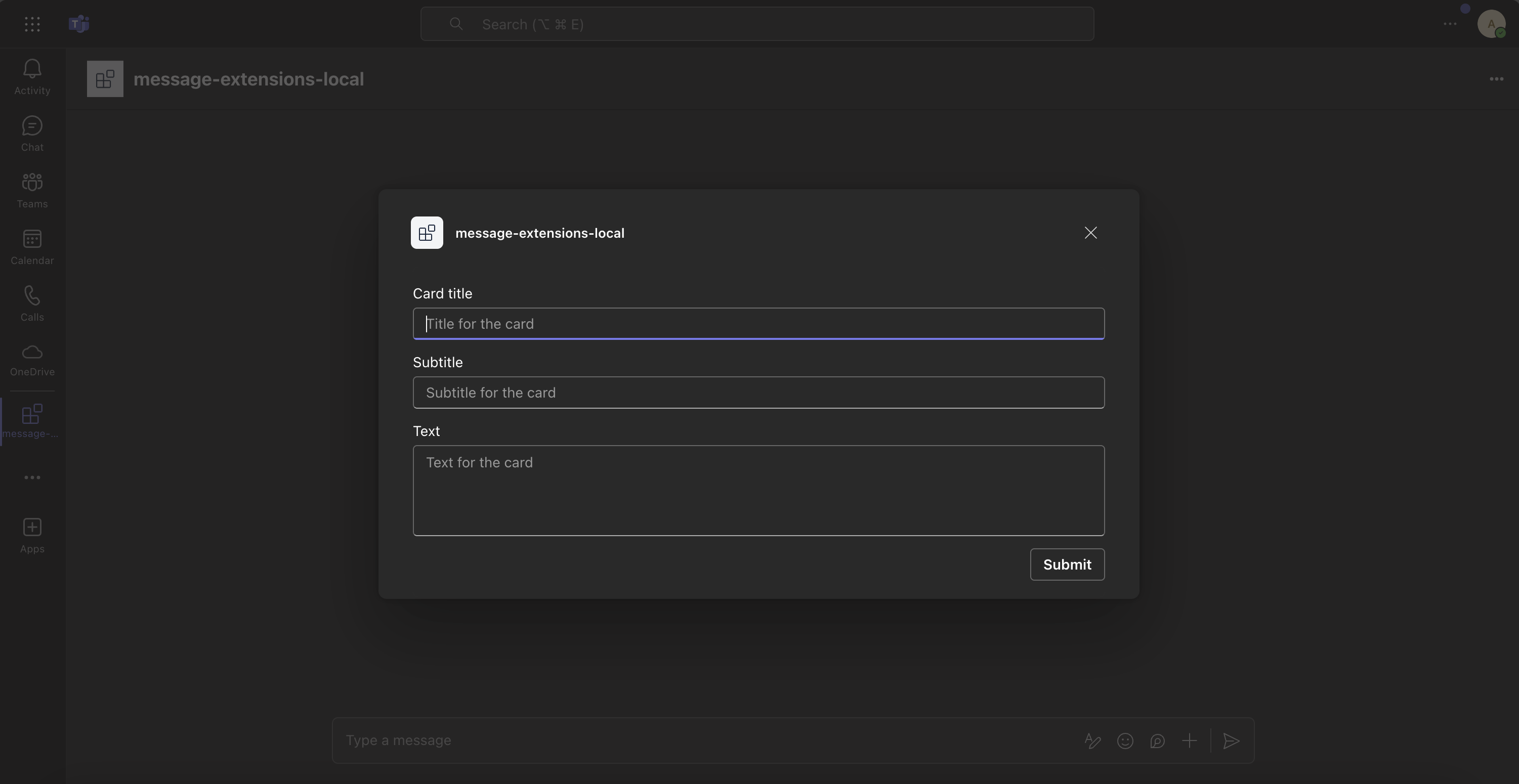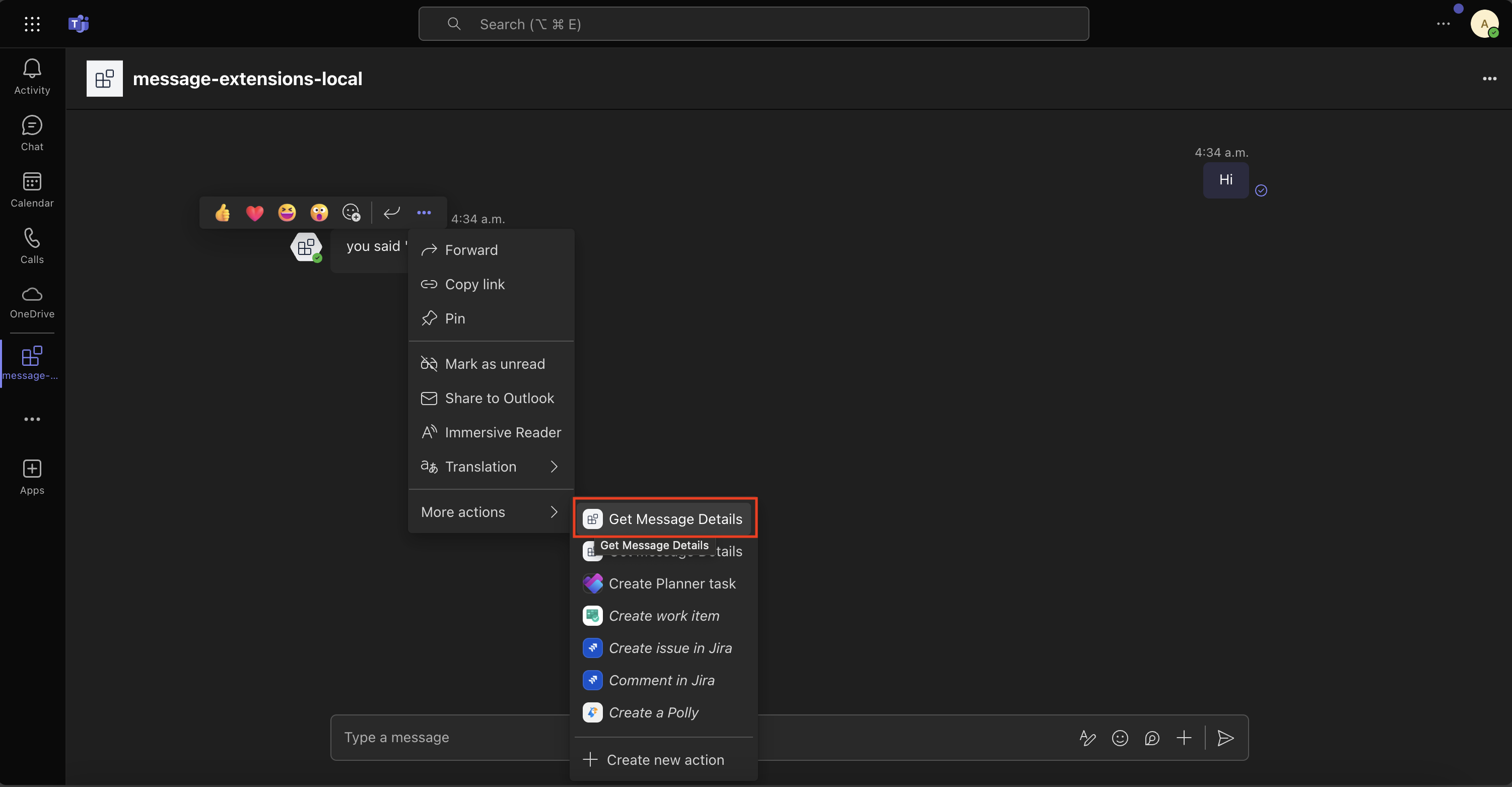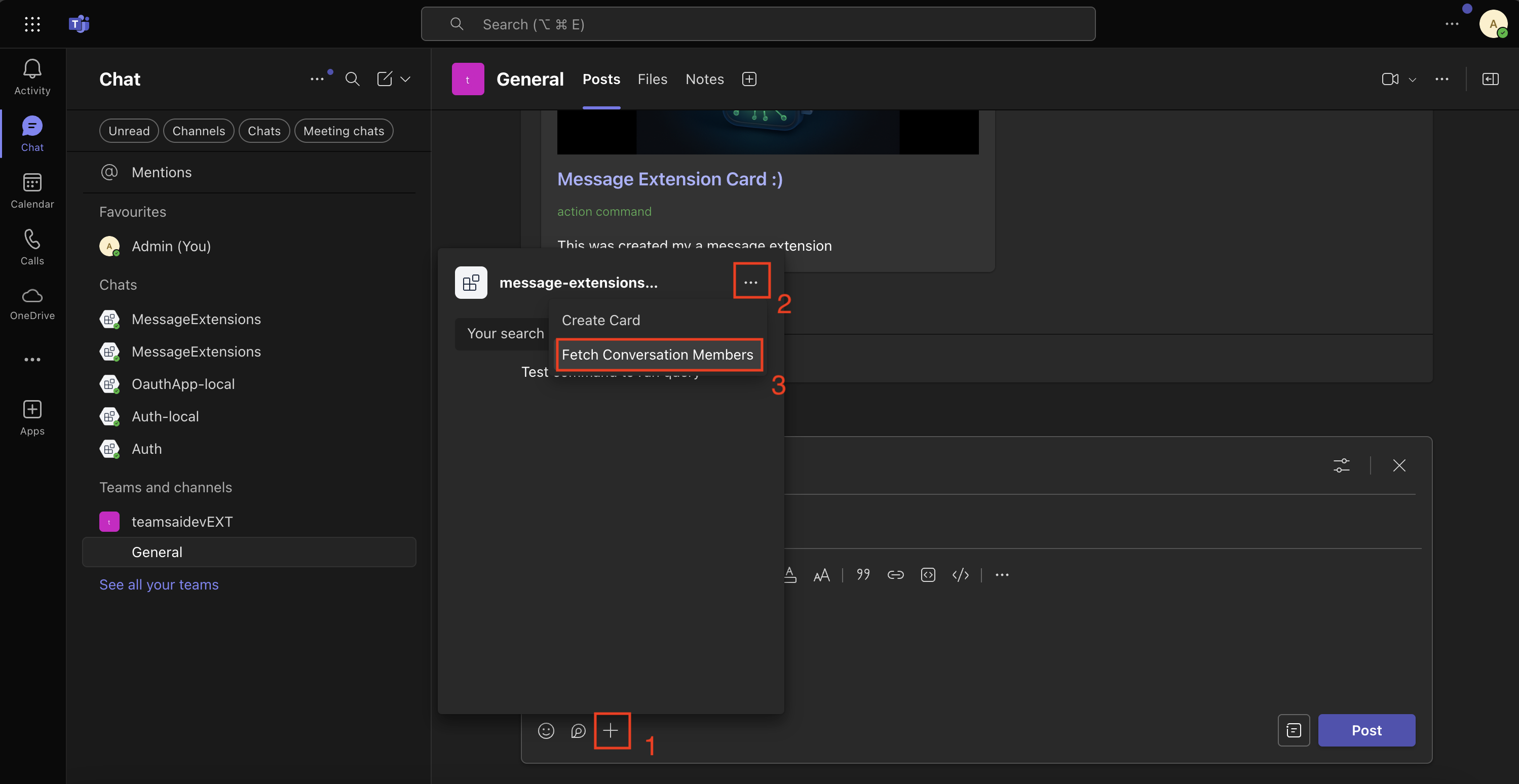Action commands
Action commands allow you to present your users with a modal pop-up called a dialog in Teams. The dialog collects or displays information, processes the interaction, and sends the information back to Teams compose box.
Action command invocation locations
There are three different areas action commands can be invoked from:
- Compose Area
- Compose Box
- Message
Compose Area and Box

Message action command

See the Invoke Locations guide to learn more about the different entry points for action commands.
Setting up your Teams app manifest
To use action commands you have define them in the Teams app manifest. Here is an example:
"composeExtensions": [
{
"botId": "${{BOT_ID}}",
"commands": [
{
"id": "createCard",
"type": "action",
"context": [
"compose",
"commandBox"
],
"description": "Command to run action to create a card from the compose box.",
"title": "Create Card",
"parameters": [
{
"name": "title",
"title": "Card title",
"description": "Title for the card",
"inputType": "text"
},
{
"name": "subTitle",
"title": "Subtitle",
"description": "Subtitle for the card",
"inputType": "text"
},
{
"name": "text",
"title": "Text",
"description": "Text for the card",
"inputType": "textarea"
}
]
},
{
"id": "getMessageDetails",
"type": "action",
"context": [
"message"
],
"description": "Command to run action on message context.",
"title": "Get Message Details"
},
{
"id": "fetchConversationMembers",
"description": "Fetch the conversation members",
"title": "Fetch Conversation Members",
"type": "action",
"fetchTask": true,
"context": [
"compose"
]
},
]
}
]
Here we have defining three different commands:
createCard- that can be invoked from either thecomposeorcommandBoxareas. Upon invocation a dialog will popup asking the user to fill thetitle,subTitle, andtext.

getMessageDetails- It is invoked from themessageoverflow menu. Upon invocation the message payload will be sent to the app which will then return the details likecreatedDate, etc.

fetchConversationMembers- It is invoked from thecomposearea. Upon invocation the app will return an adaptive card in the form of a dialog with the conversation roster.

Handle submission
Handle submission when the createCard or getMessageDetails actions commands are invoked.
from microsoft_teams.api import AdaptiveCardAttachment, MessageExtensionSubmitActionInvokeActivity, card_attachment
from microsoft_teams.api.models import AttachmentLayout, MessagingExtensionActionInvokeResponse, MessagingExtensionAttachment, MessagingExtensionResult, MessagingExtensionResultType
from microsoft_teams.apps import ActivityContext
# ...
@app.on_message_ext_submit
async def handle_message_ext_submit(ctx: ActivityContext[MessageExtensionSubmitActionInvokeActivity]):
command_id = ctx.activity.value.command_id
if command_id == "createCard":
card = create_card(ctx.activity.value.data or {})
elif command_id == "getMessageDetails" and ctx.activity.value.message_payload:
card = create_message_details_card(ctx.activity.value.message_payload)
else:
raise Exception(f"Unknown commandId: {command_id}")
main_attachment = card_attachment(AdaptiveCardAttachment(content=card))
attachment = MessagingExtensionAttachment(
content_type=main_attachment.content_type, content=main_attachment.content
)
result = MessagingExtensionResult(
type=MessagingExtensionResultType.RESULT, attachment_layout=AttachmentLayout.LIST, attachments=[attachment]
)
return MessagingExtensionActionInvokeResponse(compose_extension=result)
Create card
create_card() method
from typing import Dict
from microsoft_teams.cards import AdaptiveCard
# ...
def create_card(data: Dict[str, str]) -> AdaptiveCard:
"""Create an adaptive card from form data."""
return AdaptiveCard.model_validate(
{
"type": "AdaptiveCard",
"version": "1.4",
"body": [
{"type": "Image", "url": IMAGE_URL},
{
"type": "TextBlock",
"text": data.get("title", ""),
"size": "Large",
"weight": "Bolder",
"color": "Accent",
"style": "heading",
},
{
"type": "TextBlock",
"text": data.get("subTitle", ""),
"size": "Small",
"weight": "Lighter",
"color": "Good",
},
{"type": "TextBlock", "text": data.get("text", ""), "wrap": True, "spacing": "Medium"},
],
}
)
Create message details card
create_message_details_card() method
from typing import Dict, List, Union
from microsoft_teams.api.models.message import Message
from microsoft_teams.cards import AdaptiveCard
# ...
def create_message_details_card(message_payload: Message) -> AdaptiveCard:
"""Create a card showing message details."""
body: List[Dict[str, Union[str, bool]]] = [
{
"type": "TextBlock",
"text": "Message Details",
"size": "Large",
"weight": "Bolder",
"color": "Accent",
"style": "heading",
}
]
if message_payload.body and message_payload.body.content:
content_blocks: List[Dict[str, Union[str, bool]]] = [
{"type": "TextBlock", "text": "Content", "size": "Medium", "weight": "Bolder", "spacing": "Medium"},
{"type": "TextBlock", "text": message_payload.body.content},
]
body.extend(content_blocks)
if message_payload.attachments:
attachment_blocks: List[Dict[str, Union[str, bool]]] = [
{"type": "TextBlock", "text": "Attachments", "size": "Medium", "weight": "Bolder", "spacing": "Medium"},
{
"type": "TextBlock",
"text": f"Number of attachments: {len(message_payload.attachments)}",
"wrap": True,
"spacing": "Small",
},
]
body.extend(attachment_blocks)
if message_payload.created_date_time:
date_blocks: List[Dict[str, Union[str, bool]]] = [
{"type": "TextBlock", "text": "Created Date", "size": "Medium", "weight": "Bolder", "spacing": "Medium"},
{"type": "TextBlock", "text": message_payload.created_date_time, "wrap": True, "spacing": "Small"},
]
body.extend(date_blocks)
if message_payload.link_to_message:
link_blocks: List[Dict[str, Union[str, bool]]] = [
{"type": "TextBlock", "text": "Message Link", "size": "Medium", "weight": "Bolder", "spacing": "Medium"}
]
body.extend(link_blocks)
actions = [{"type": "Action.OpenUrl", "title": "Go to message", "url": message_payload.link_to_message}]
else:
actions = []
return AdaptiveCard.model_validate({"type": "AdaptiveCard", "version": "1.4", "body": body, "actions": actions})
Handle opening adaptive card dialog
Handle opening adaptive card dialog when the fetchConversationMembers command is invoked.
from microsoft_teams.api import AdaptiveCardAttachment, MessageExtensionFetchTaskInvokeActivity, card_attachment
from microsoft_teams.api.models import CardTaskModuleTaskInfo, MessagingExtensionActionInvokeResponse, TaskModuleContinueResponse
from microsoft_teams.apps import ActivityContext
# ...
@app.on_message_ext_open
async def handle_message_ext_open(ctx: ActivityContext[MessageExtensionFetchTaskInvokeActivity]):
conversation_id = ctx.activity.conversation.id
members = await ctx.api.conversations.members(conversation_id).get_all()
card = create_conversation_members_card(members)
card_info = CardTaskModuleTaskInfo(
title="Conversation members",
height="small",
width="small",
card=card_attachment(AdaptiveCardAttachment(content=card)),
)
task = TaskModuleContinueResponse(value=card_info)
return MessagingExtensionActionInvokeResponse(task=task)
Create conversation members card
create_conversation_members_card() method
from typing import List
from microsoft_teams.api import Account
from microsoft_teams.cards import AdaptiveCard
# ...
def create_conversation_members_card(members: List[Account]) -> AdaptiveCard:
"""Create a card showing conversation members."""
members_list = ", ".join(member.name for member in members if member.name)
return AdaptiveCard.model_validate(
{
"type": "AdaptiveCard",
"version": "1.4",
"body": [
{
"type": "TextBlock",
"text": "Conversation members",
"size": "Medium",
"weight": "Bolder",
"color": "Accent",
"style": "heading",
},
{"type": "TextBlock", "text": members_list, "wrap": True, "spacing": "Small"},
],
}
)